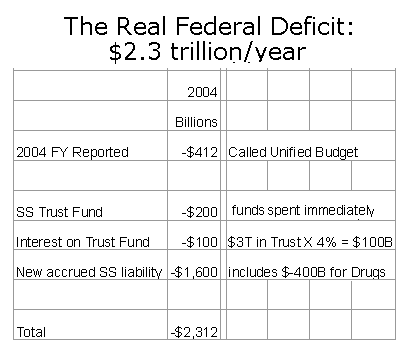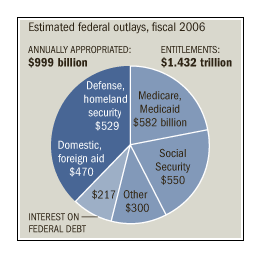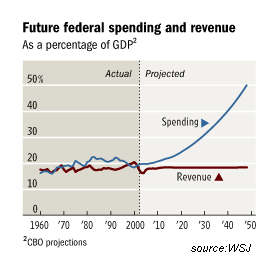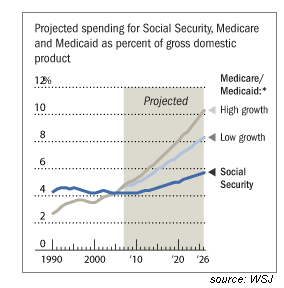| |
Where There Is Ruin II: Social Security
(July 25, 2006)
 Correspondant Michael Goodfellow has graciously allowed me to reprint his analysis
of the looming Social Security funding crisis.
Correspondant Michael Goodfellow has graciously allowed me to reprint his analysis
of the looming Social Security funding crisis.
The net result: the crisis isn't decades
away--it's only a few years away. Read on to see why. (emphasis added in bold is mine.)
Michael tells me the statistics were assembled a year ago, but I don't think newer data
would affect his analysis; the forces being measured are the demographics
of the baby boom, which were set in the period 1946-1964. The only variable is when Boomers
retire--at 62 or 66--and that will not materially change the dire financial circumstances
we face.
The accompanying charts are not Michael's, but they provide graphic
representations of the problem he so ably describes.
Here is his analysis:
It's hard to make heads or tails of the current debate over Social Security. Sometimes it
seems like you just have to find an editorial you like the sound of and trust it. After all,
how could you know anything personally about the future of Social Security? But it turns
out, you can do a bit of research on your own. The figures involved are not a secret!
The best reference for this kind of thing is put out by the U.S. Census Bureau, and it's
called "The Statistical Abstract of the United States." Find it online at
Abstract of the U.S..
 Since the debate is all about handling the Baby Boom retirees, start with the age of
Americans. Here is the 2003 age distribution:
Since the debate is all about handling the Baby Boom retirees, start with the age of
Americans. Here is the 2003 age distribution:
59 yrs. old 2,788,000
58 yrs. old 2,785,000
57 yrs. old 3,064,000
56 yrs. old 3,495,000
55 yrs. old 3,662,000
The people 57 years old in 2003 will be 65 in 2011. So in four years, 2010 to 2013, the
number of new retirees per year will jump by 874,000 people. That will be when the expense
of Social Security (and Medicare!) suddenly takes a jump. Trust funds and Social Security
taxes make no difference -- it's all one budget.
In 2002, there were 34.7 million elderly on Medicare, for a total expenditure of $125.3
billion, or $3600 per retiree. Social Security was $472.6 billion in 2002, so figure
$13,600 per person.
 Adding 8% medical inflation from now until then, and 3% Social Security inflation (both
low estimates), you get this estimate:
Adding 8% medical inflation from now until then, and 3% Social Security inflation (both
low estimates), you get this estimate:
In 2011, the new crop of retirees adds $7 billion over what a 2009 sized group would have
required. But the next year adds another large group and so on:
2012 $25.6 billion excess over two 2009-sized groups
2013 $50.5 billion
2014 $73.1 billion
2015 $99.7 billion
2016 $125.7 billion
2017 $156.3 billion
2018 $189.6 billion
Now of course, retirees are also dying, so you might think this is only half the story.
However, the people who die are, on the average, 15 years older than the new retirees.
So when the number of retirees surges in 2011, the number of deaths is still from the
pre-boomer group, and stays roughly constant.
 In other words, Social Security and Medicare outlays continue to increase for 15 years,
until the number of retirees dying rises to match the number of new retirees.
In other words, Social Security and Medicare outlays continue to increase for 15 years,
until the number of retirees dying rises to match the number of new retirees.
Also realize that since the U.S. population is growing, the number of retirees would grow,
even if there had been no baby boom. So the table above is not a total cost of Social
Security and Medicare. It's the additional cost over what the baseline 2009 group would have required, with inflation added.
The debate you read will be about when Social Security expenses exceed taxes (in 2018),
or when the "trust fund" is exhausted (in 2042.) Private accounts are supposed to relieve
these problems. But my point here is that the budget starts to increase as soon as the
number of retirees increases. At that point, the government has to either raise taxes,
cut other programs, cut Social Security and Medicare, or (most likely) borrow more money.
This will happen starting in 2011, not in "our children's future." This is too soon for
private accounts to have any effect on the solvency of Social Security. As far as I know,
nothing has been proposed to deal with Medicare. The recent Medicare drug benefit just
makes things worse.
Thank you, Michael, for a cogent and devastating analysis of a ruinous crisis for which
we as a nation have no solution. To repeat Newt Gingrich's comment from yesterday's entry:
"We're going to be hit over
the next 15 or 20 years with so many different things simultaneously that the total number
of solutions we have to come up with is going to stretch our capacity as a society to
talk to itself well enough to actually reach agreement to get something done."
For more on this subject and a wide array of other topics, please visit
my weblog.
copyright © 2006 Charles Hugh Smith. All rights reserved in all media.
I would be honored if you linked this wEssay to your site, or printed a copy for your own use.
|
|


 Correspondant Michael Goodfellow has graciously allowed me to reprint his analysis
of the looming Social Security funding crisis.
Correspondant Michael Goodfellow has graciously allowed me to reprint his analysis
of the looming Social Security funding crisis.